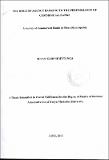The Role of Agency Banking to the Performance of Commercial Banks: A Survey of Commercial Banks in Meru Municipality

View/
Date
2013-06Author
Mutunga, Karimi Susan
Type
ThesisLanguage
enMetadata
Show full item recordAbstract
About eighty percent of Kenyans have no access to banking services in Kenya. The main challenge facing the Kenyan banks has been reaching the rural population. Most of the people living in rural areas in Kenya have no regular source of income because of their high dependence on agriculture as a means of earning their living. Most of the mainstream banks are localized in urban areas. Travelling to towns for most people in rural areas is costly and time consuming. The Kenya commercial banks have come up with the agency banking model in attempt to reach the unbanked rural population. The rationale in agency banking has been to enable the ready access at the place of the clients, reducing transaction cost to make the services affordable, reduction in delays and improving the quality of services available.
Agency banking is facing a myriad of challenges; key among them is their profitability as most of them serve clients who have limited savings. The agent banks must be able to pay the agency banking managers/retailers, and also earn profit for the banks. The agent banks also have limited operations and this has led the Kenyan commercial banks to question their profitability. It is in this regard that the research sought to find out the contributions of agency banking in the performance of Kenyan commercial banks. The study employed descriptive research design. The target population included: banking agent supervisors and the agent banking managers who total to 210 where a sample of 63 was drawn using stratified random sampling. A questionnaire was used as the data collection tool and it was administered using the drop and pick method. Descriptive statistics was used to analyze the data and correlation analysis done to establish correlation between the new model of agency banking .and performance of banks. The data was presented inform of tables, graphs, pie-charts and finally qualitative analysis was done. To increase reliability and validity of the instrument a pilot study was conducted on 5% of the sample before the instrument was fmally administered to the respondents. The response rate was 82.3% agents and 100% for agency banking managers. The data established that majority of the agents are female business ladies; improved profit margins and safeguarding interest of banks has influenced people to embrace agency banking. It also established that agency banking has improved the customer base of banks. Factors such as location, cost, efficiency and services provided by agency banking has increased customers. Finally agency banking has attracted customers through application of the marketing mix elements. It was recommended that banks should develop education programs targeting the rural
Publisher
KeMU
Description
HG 3267.M8 2013
